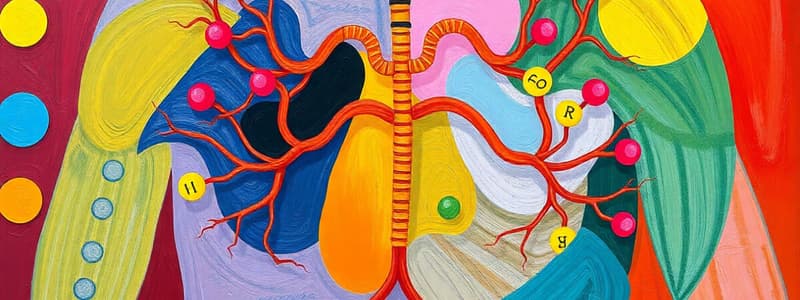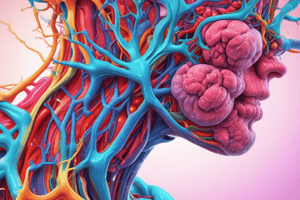Podcast
Questions and Answers
Which of the following hormones are derived from tryptophan?
Which of the following hormones are derived from tryptophan?
Which of the following is NOT an eicosanoid?
Which of the following is NOT an eicosanoid?
Which of the following hormones is a glycoprotein?
Which of the following hormones is a glycoprotein?
Which of the following is NOT a function of transport proteins for hormones?
Which of the following is NOT a function of transport proteins for hormones?
Signup and view all the answers
Which of the following is the primary precursor molecule for steroid hormones?
Which of the following is the primary precursor molecule for steroid hormones?
Signup and view all the answers
Which of the following is an example of a small protein hormone?
Which of the following is an example of a small protein hormone?
Signup and view all the answers
Which of these statements is TRUE about prohormones?
Which of these statements is TRUE about prohormones?
Signup and view all the answers
Which of the following communication methods is characterized by the exchange of ions and molecules directly between two cells of the same type?
Which of the following communication methods is characterized by the exchange of ions and molecules directly between two cells of the same type?
Signup and view all the answers
Which of the following hormones is NOT produced by the adrenal cortex?
Which of the following hormones is NOT produced by the adrenal cortex?
Signup and view all the answers
What is the primary function of hormones?
What is the primary function of hormones?
Signup and view all the answers
Which of the following statements is TRUE about the inactivation of hormones?
Which of the following statements is TRUE about the inactivation of hormones?
Signup and view all the answers
Which of the following best describes the process of hormone inactivation?
Which of the following best describes the process of hormone inactivation?
Signup and view all the answers
What is the primary difference between endocrine and exocrine cells?
What is the primary difference between endocrine and exocrine cells?
Signup and view all the answers
Which of the following is NOT a characteristic shared by both the nervous and endocrine systems?
Which of the following is NOT a characteristic shared by both the nervous and endocrine systems?
Signup and view all the answers
Which communication method is best suited for crisis management and rapid, targeted responses?
Which communication method is best suited for crisis management and rapid, targeted responses?
Signup and view all the answers
How do hormones alter the metabolic activities of target cells?
How do hormones alter the metabolic activities of target cells?
Signup and view all the answers
Which type of intercellular communication involves chemical signals that influence the same cells that secrete them?
Which type of intercellular communication involves chemical signals that influence the same cells that secrete them?
Signup and view all the answers
In which type of intercellular communication are chemical signals released into the bloodstream and travel to distant target cells?
In which type of intercellular communication are chemical signals released into the bloodstream and travel to distant target cells?
Signup and view all the answers
What is the defining characteristic of cells that are considered target cells?
What is the defining characteristic of cells that are considered target cells?
Signup and view all the answers
Which of the following statements accurately describes the role of the endocrine system in maintaining homeostasis?
Which of the following statements accurately describes the role of the endocrine system in maintaining homeostasis?
Signup and view all the answers
Which of the following statements is TRUE concerning the role of phosphodiesterase (PDE) in cellular signaling?
Which of the following statements is TRUE concerning the role of phosphodiesterase (PDE) in cellular signaling?
Signup and view all the answers
Which of the following is a function of the activated G protein in the cAMP signaling pathway?
Which of the following is a function of the activated G protein in the cAMP signaling pathway?
Signup and view all the answers
In the calcium signaling pathway, IP3 triggers the release of calcium from intracellular stores by...
In the calcium signaling pathway, IP3 triggers the release of calcium from intracellular stores by...
Signup and view all the answers
What is the primary role of calcium ions in the signaling pathway involving inositol triphosphate (IP3)?
What is the primary role of calcium ions in the signaling pathway involving inositol triphosphate (IP3)?
Signup and view all the answers
In the context of the cAMP signaling pathway, which of the following is NOT a direct consequence of increased cAMP levels?
In the context of the cAMP signaling pathway, which of the following is NOT a direct consequence of increased cAMP levels?
Signup and view all the answers
Which of the following accurately describes the primary mechanism by which steroid hormones exert their effects on target cells?
Which of the following accurately describes the primary mechanism by which steroid hormones exert their effects on target cells?
Signup and view all the answers
How do thyroid hormones differ from steroid hormones in their mode of action?
How do thyroid hormones differ from steroid hormones in their mode of action?
Signup and view all the answers
Which of the following is an accurate comparison between first messengers and second messengers in a signaling pathway?
Which of the following is an accurate comparison between first messengers and second messengers in a signaling pathway?
Signup and view all the answers
Which of the following is an example of a second messenger molecule involved in signal transduction pathways?
Which of the following is an example of a second messenger molecule involved in signal transduction pathways?
Signup and view all the answers
In the context of cell signaling, what distinguishes a second messenger from a first messenger?
In the context of cell signaling, what distinguishes a second messenger from a first messenger?
Signup and view all the answers
Which of the following hormones would be classified as a 'first messenger'?
Which of the following hormones would be classified as a 'first messenger'?
Signup and view all the answers
A cell that is exposed to high levels of a particular hormone will likely exhibit which of the following adaptations?
A cell that is exposed to high levels of a particular hormone will likely exhibit which of the following adaptations?
Signup and view all the answers
Which of the following best describes the role of a G-protein in hormone signaling?
Which of the following best describes the role of a G-protein in hormone signaling?
Signup and view all the answers
Which of the following pairs of hormones and their associated receptors is CORRECT?
Which of the following pairs of hormones and their associated receptors is CORRECT?
Signup and view all the answers
The process of amplification in hormone signaling refers to:
The process of amplification in hormone signaling refers to:
Signup and view all the answers
Which of the following is NOT a characteristic of steroid hormones?
Which of the following is NOT a characteristic of steroid hormones?
Signup and view all the answers
The presence of specific hormone receptors on a target cell determines which of the following?
The presence of specific hormone receptors on a target cell determines which of the following?
Signup and view all the answers
Which of the following is a common mechanism by which hormones regulate intracellular processes?
Which of the following is a common mechanism by which hormones regulate intracellular processes?
Signup and view all the answers
Which of the following is TRUE regarding down-regulation of hormone receptors?
Which of the following is TRUE regarding down-regulation of hormone receptors?
Signup and view all the answers
How does the binding of a hormone to its receptor on the plasma membrane typically initiate a cellular response?
How does the binding of a hormone to its receptor on the plasma membrane typically initiate a cellular response?
Signup and view all the answers
Study Notes
Endocrine System Introduction
- Endocrine cells produce about 30 different hormones (chemical messengers)
- Hormones control and coordinate bodily functions
- Homeostasis is maintained through intercellular communication from the nervous and endocrine systems
Mechanisms of Intercellular Communication
- Direct communication: Exchange of ions and molecules between adjacent cells via gap junctions (rare)
- Paracrine communication: Chemical signals transfer information between cells within the same tissue
- Autocrine communication: Chemical signals affect the same cells that secrete them (e.g., prostaglandins)
-
Endocrine communication: Cells release hormones into the bloodstream that affect distant target cells with receptors
- Alters metabolic processes in many organs
- Target cells need receptors to "read" hormonal messages
- Hormones: Chemical messengers that modify enzyme types, quantities, and structural protein activities in target cells, potentially affecting long-term processes, or triggering fast responses like action potentials
- Synaptic communication: Neurons release neurotransmitters at a synapse, resulting in fast, high-speed communication to specific destinations, ideal for rapid responses
Comparisons of Endocrine and Nervous Systems
- Both rely on chemical signaling to receptors on target cells
- Share similar chemical messengers (e.g., norepinephrine and epinephrine)
- Both are regulated by negative feedback mechanisms
- Maintain homeostasis by coordinating and regulating activities
Classes of Hormones
- Hormones are categorized into amino acid derivatives, peptide hormones, and lipid derivatives (eicosanoids and steroid hormones)
- Amino acid derivatives are small molecules related to amino acids (e.g., thyroid hormones, catecholamines).
- Peptide hormones are chains of amino acids, synthesized as prohormones (inactive) that are later activated
- Lipid derivatives include eicosanoids (derived from arachidonic acid) and steroid hormones (derived from cholesterol)
- Steroid hormones remain in circulation longer than peptide hormones (bound to carrier proteins, longer half-life)
- Eicosanoids coordinate local cellular activities and have varying transport mechanisms depending on their nature
Transport and Inactivation of Hormones
- Some hormones circulate freely; others travel bound to carrier proteins
- Free hormones remain active for a short time before being inactivated/degraded by:
- Diffusion out of the bloodstream and binding to receptors
- Absorption and breakdown by the liver or kidneys
- Enzymatic breakdown in the blood or interstitial fluids
Hormone Receptors and Action
- Hormone receptors are proteins on target cells that bind strongly to specific hormones
- Presence/absence of a receptor determines a cell's sensitivity
- Hormone concentration affects the receptor number and therefore sensitivity
- Hormone receptors can be located on plasma membranes or inside target cells
- Intracellular receptors respond differently depending on the location; extracellular receptors often use second messenger systems to amplify the hormone's effect
Intracellular/Extracellular Responses
- Extracellular receptors respond to hormones that cannot enter the cell directly, often relying on second messengers like cAMP to produce a cascade of intracellular activity to amplify the response from a small number of hormones
- Intracellular receptors respond to lipid-soluble hormones, that freely cross the plasma membrane, and often influence gene transcription
Mechanisms of Hormone Amplification
- Hormones bind to extracellular receptors
- This causes thousands of second messengers to appear, amplifying the signal significantly
- Multiple steps amplify the initial hormonal signal, creating a noticeable reaction
G-proteins and cAMP
- G-proteins are enzyme complexes coupled to membrane receptors, facilitating the link between hormones and cAMP (a second messenger).
- Hormones activate G-proteins, typically resulting in specific cellular changes.
Phosphodiesterase (PDE)
- PDE converts cAMP to AMP, ending cAMP signaling
- This rapid control of cAMP ensures appropriate cellular response
Studying That Suits You
Use AI to generate personalized quizzes and flashcards to suit your learning preferences.
Related Documents
Description
This quiz explores the key concepts of the endocrine system, including the various hormones produced and their roles in maintaining homeostasis. It covers the mechanisms of intercellular communication and how hormones affect bodily functions. Test your understanding of how these chemical messengers operate within the body.



